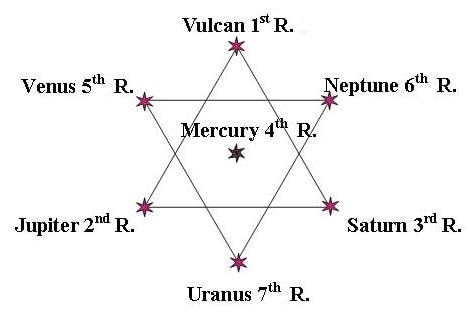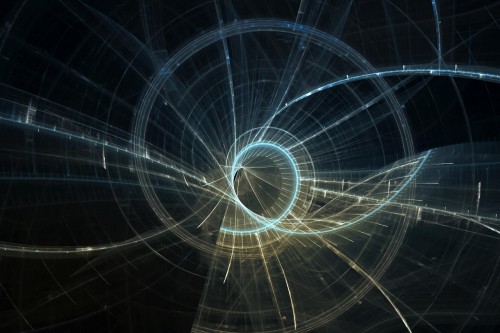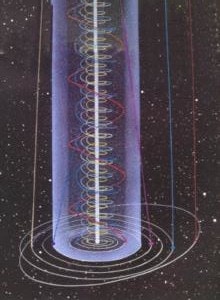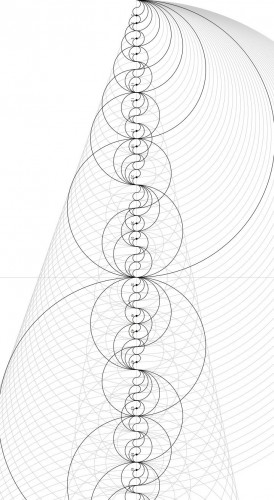
THE SOLAR STAR*
The seven Luminaries form a six-pointed star, referred to here, simply, as the solar star [1] (see this previous article). … The entire study concerns the solar star, its two triangles, its movements, its rhythms and the orbits of its vertices.
THE ACCURACY OF CALCULATIONS
The considerations treated here require few, uncomplicated calculations, but it is as well to touch on the subject of their exactness, which has deep implications; in common use the idea has assumed distorted significance and importance.
As far as calculations go it is a general, rooted conviction that the realm of exact measures is the physical world, in fact science in general abstains from measuring intangible objects, for example the tension of any feeling. Such a conviction is projected globally onto the formless, imperceptible world which the senses do not reveal, which is generally considered, when its existence is admitted, to be the real realm of the vague, imprecise, indefinite and debatable.
Here we begin from the opposite position, that the spiritual is the exclusive domain of exactness, of absolute precision without error, the realm where neither imprecision or compromise exist. Following this point of view, the concrete world (from thought-forms to emotions to physical phenomena), because of the illusions caused by false intellectual, psychic and sensory perceptions, is the field where imprecision is the rule and uncertainty reigns.
A similar reversal of position is necessary to eliminate harmful mental assumptions, which are totally unjustified, never demonstrated and even without a logical basis.
*
The figures assumed here as a starting point regarding the periods of rotation of the Luminaries do not coincide with those provided by science. The differences are listed below:
| Period of rotation | |||||
| Luminary | Official | Assumed | Percentage difference | ||
| Mercury | 87,97 days | 90 days | +0,98% | ||
| Venus | 227,4 days | 225 days | -1,00% | ||
| Jupiter | 11,86 years | 12 years | +0,99% | ||
| Saturn | 29,46 years | 30 years | +0,98% | ||
| Uranus | 84 years | 84 years | – | ||
| Neptune | 164,8 years | 168 years | +0,98% | ||
As can be noted, the differences from the official dates are minimum, about one per cent, and, most importantly, they are all in the same order of greatness.
*
One might talk at length about the scientific data. For the aforementioned reason they cannot be exact, but only approximate “enough”. But there is a second reason, of a different nature and of equal importance, which concerns the evaluation of astronomical cycles.
The spiritual and geometrical law governing the evolutionary motion is the spiral. If cycles had a beginning and end that coincided, one could not speak of progress of any kind and, as a consequence, living forms would not exist. By the law of the spiral the manifested life is always new in every phase or beat of any cycle and this is demonstrated in the fact that (whether science knows it or not) beginning and end always coincide in the formless world, that is, of exactness, of Fire, and never in that of appearances, concrete or subtle, which are subject to change and progress.

The distance between the beginning and end, in every kind of phenomenon, is a parameter that varies with the level of consciousness of the entity that manifests through it itself and signals its major or minor evolutionary step, which is also variable according to its phase of development. In fact, evolutionary motion can and must be accelerated. A constant, uniform pace of progress is not sufficient to avoid stagnation and, consequently, death.
Such statements carry us far and deserve to be studied in depth: they concern a primary law, not yet recognized by official science. Here, however, it is appropriate to limit the study to the case in question and to recognize that the astronomical data are not entirely credible, because (among other things) they completely ignore the spiral law. It is possible that a part of those inaccuracies that appear are due to its action.
*
The difference in statistics pointed out in the preceding list is not a simple, arbitrary rounding off, made to facilitate calculations, which here in any case are few and all elementary. The reason is very different and needs to be highlighted:
The parameters assumed here as a basis for calculating solar cycles and rhythms are proportional with each other, that is, they are based on harmonics.
Whoever has a clear concept of the creative power of sound will easily understand the importance of the correlation occurring between the movements of the Luminaries; as we have seen, in order to be noted this requires only a slight correction of the official astronomical data, which in any case is already imperfect.
Here is a series that groups all the sound relationships between the periods of revolution of the seven Luminaries, based on the data taken from the previous table. They are indicated according to the musical notation in use and arranged for increasing frequencies:

A first comment to this result[2] is that the whole of the Solar System – limited to its major centers and with regard to their periods of revolution – is in a harmonious structure somewhat similar to a musical scale. The vision of an order emerges (which Kepler intuited and sought), of a creative nature connected to the laws of sound and therefore based on harmony and beauty.
THE BREATH OF THE LUMINARIES
This topic has already been dealt with on another occasion (see commentary on Infinity 2, par 1-2)[3], but here it is found in its specific context and it seems fair to re-examine it. Everything is based on a proposition of the Master of Agni Yoga:
Each turn of the planet accumulates energy. (INFINITY 2, par.1)
 This phrase is fundamental in understanding the Solar System’s energetic economy. In Space infinite energy currents of various potential, quality and level, circulate. Each Luminary, following its own orbit, crosses their flows, regulated by cosmic magnetism, which is divine love. Moreover, rotating around its polar axis, it exposes its entire surface to solar radiation, in an alternating but perfectly balanced way. This movement determines the daily cycle, a minimum unit of rhythm, but a fundamental one for the evolution of all its creatures.
This phrase is fundamental in understanding the Solar System’s energetic economy. In Space infinite energy currents of various potential, quality and level, circulate. Each Luminary, following its own orbit, crosses their flows, regulated by cosmic magnetism, which is divine love. Moreover, rotating around its polar axis, it exposes its entire surface to solar radiation, in an alternating but perfectly balanced way. This movement determines the daily cycle, a minimum unit of rhythm, but a fundamental one for the evolution of all its creatures.
These movements and alternations allow the Luminaries to extract from solar Space, each in its own fashion and measure, the qualified energy by which its forms of life are nourished. If the planet stopped rotating, they would perish with it.
From this these considerations may be deduced:
- – The rotary movement is for the planet the equivalent of what breathing is for man and many other living forms.
- – The true cause of energy taken from Space through rotation is the cyclic alternation, mutable but regular, of light and shadow, or positive and negative. The planet “breathes” because the two spatial polarities are in harmonious exchange, as in a pendulum.
- – Celestial bodies without an autonomous rotation are dead, true decaying corpses, and it is useless to suppose that they can support forms of life. The Moon is the most obvious example. Its rotation is not autonomous, but driven by that of the Earth around its own orbit. It is therefore dead.
- – The fact that the Sun, placed at the center of the System, rotates, guarantees the possibility of life to all similarly rotating forms of its community. Moreover, this reveals its dependence on another greater stellar Centre, as yet not clearly defined by science. The Sun also reveals its surface to a higher Light in an alternate and regular way. The Sun breathes.
- – In breathing, the planets draw from solar Space the energies that flow there: the Sun, in its turn, draws these from a vaster, higher environment, and concentrates and distributes them.
The Luminaries are definitely Centers, each one bearers of countless minor centers, and from what has been stated it can be deduced that any center, as such and no matter what is its hierarchical position, must:
- Rotate on its axis in a regular, stable way.
- Revolve around a greater center.
- In the absence of either of these movements, that center, unable to nourish itself, could no longer receive, accommodate and elaborate life and would eventually die out and be extinguished.
A Center rotates only if it is switched on, that is, alive and pulsating. The rotational motion (which actually proceeds in a spiral) is a characteristic of Fire.

* by E. Savoini, 1993 – thanks to Jancis, Enrica and Simon for the ongoing revised translation – links, underlining and pictures are by TPS editorial staff.
This article is published in the Date of the heliocentric conjunction between Mercury (4th Ray) and Uranus (7th Ray).
[1] From the Book of Rituals page 63, unpublished text: “With the name of a solar star we mean the complex of energies, rhythms, qualities, geometries and astrological properties constituted by the seven sacred planets of the solar system” – TN.
[2] The music of the spheres is not a mythical tale or a philosophical vision. It originates from the fact that every relationship expresses a sound interval. Therefore, the relationship between the various periods of revolution of the planets is literally a music. For example, between Uranus and Neptune there is a ratio of 1/2 (84/168), which corresponds to an octave interval or DO. The table is obtained calculating all the relationships that are generated between the seven sacred Luminaries (fractions express lengths). In detail: Uranus / Neptune: 1/2 = DO; Venus / Uranus: 5/21 = DO #; Venus / Jupiter: 5/6 = MIb or RE #; Jupiter / Saturn and Mercury / Venus: 2/5 = MI; Mercury / Uranus: 1/21 = FA; Saturn / Uranus: 5/14 = FA # (or SOLb); Venus / Saturn and Mercury / Jupiter: 1/48 = SOL; Jupiter / Uranus: 1/7 = LA # (or SIb); Mercury / Saturn: 1/15 = SI. In the text appears a LAb whose origin cannot be explained, while the RE # or MIb of the Venus / Jupiter ratio is 5/6. [TN]
[3] The text is published (in Italian): Primo Vertice, Commento a Infinito Parte I e II, Roma Casa Editrice Nuova Era, 2003.





